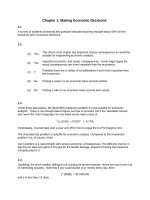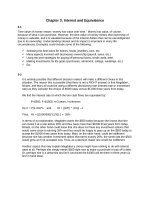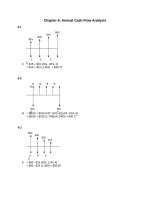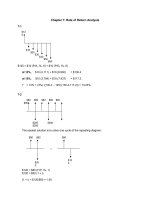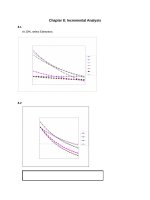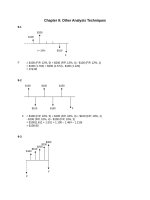Solution manual engineering economic analysis 9th edition ch07 rate of return analysis
Bạn đang xem bản rút gọn của tài liệu. Xem và tải ngay bản đầy đủ của tài liệu tại đây (112.55 KB, 25 trang )
Chapter 7: Rate of Return Analysis
7-1
$12
5
$10
$20
$30
$40
$50
$60
$125 = $10 (P/A, i%, 6) + $10 (P/G, i%, 6)
at 12%,
$10 (4.111) + $10 (8.930)
= $130.4
at 15%,
$10 (3.784) + $10 (7.937)
= $117.2
i*
= 12% + (3%) ((130.4 – 125).(130.4-117.2)) = 13.23%
7-2
$80
$80
$80
$200
$200
$80
$80
$80
$200
The easiest solution is to solve one cycle of the repeating diagram:
$80
$80
$80
=
$20
0
$120 = $80 (F/P, i%, 1)
$120 = $80 (1 + i)
(1 + i) = $120/$80 = 1.50
$12
0
i* = 0.50 = 50%
Alternative Solution:
EUAB = EUAC
$80 = [$200 (P/F, i%, 2) + $200 (P/F, i%, 4) + $200 (P/F, i%, 6)] (A/P, i%, 6)
Try i = 50%
$80 = [$200 (0.4444) + $200 (0.1975) + $200 (0.0878)] (0.5481)
Therefore i* = 50%.
7-3
$5
$10
$15
$20
$25
$42.55
$42.55 = $5 (P/A, i%, 5) + $5 (P/G, i%, 5)
Try i = 15%, $5 (3.352) + $5 (5.775) = $45.64 > $42.55
Try i = 20%,
$5 (2.991) + $5 (4.906) = $39.49 < $42.55
Rate of Return
= 15% + (5%) [($45.64 - $42.55)/($45.64 - $39.49)]
= 17.51%
Exact Answer:
17.38%
7-4
For infinite series: A = Pi
EUAC= EUAB
$3,810 (i) = $250 + $250 (F/P, i%, 1) (A/F, i%, 2)*
Try i = 10%
$250 + $250 (1.10) (0.4762)
= $381
$3,810 (0.10)
= $381
i = 10%
*Alternate Equations:
$3,810 (i)
= $250 + $250 (P/F, i%, 1) (A/P, i%, 2)
$3,810 (j)
= $500 - $250 (A/G, i%, 2)
= $79.99
7-5
P’
A = $1,000
………….
Yr 0
n = 10
$41
2
n=∞
$5,00
0
At Year 0, PW of Cost = PW of Benefits
$412 + $5,000 (P/F, i%, 10)
= ($1000/i) (P/F, i%, 10)
Try i = 15%
$412 + $5,000 (0.2472)
$1,648
= ($1,000/0.15) (0.2472)
= $1,648
ROR = 15%
7-6
The algebraic sum of the cash flows equals zero. Therefore, the rate of return is 0%.
7-7
A = $300
$1,00
0
Try i = 5%
$1,000 =(?)
Try i = 6%
$1,000 =(?)
$300 (3.546) (0.9524)
=(?) $1,013.16
$300 (3.465) (0.9434)
=(?) $980.66
Performing Linear Interpolation:
i*
= 5% + (1%) (($1,013.6 - $1,000)/($1,013.6 - $980.66))
= 5.4%
7-8
$400 = [$200 (P/A, i%, 4) - $50 (P/G, i%, 4)] (P/F, i%, 1)
Try i = 7%
[$200 (3.387) - $50 (4.795)] (0.9346)
= 409.03
Try i = 8%
[$200 (3.312) - $50 (4.650)] (0.9259)
= $398.08
i*
= 7% + (1%) [($409.03 - $400)/($409.03 - $398.04)]
= 7.82%
7-9
$100
(P/A, i%, 10)
= $27 (P/A, i%, 10)
= 3.704
Performing Linear Interpolation:
(P/A, i%, 10) i
4.192
20%
3.571
25%
Rate of Return
= 20% + (5%) [(4.192 – 3.704)/(4.912 – 3.571)]
= 23.9%
7-10
Year
0
1
2
3
4
5
Cash Flow
-$500
-$100
+$300
+$300
+$400
+$500
$500 + $100 (P/F, i%, 1)= $300 (P/A, i%, 2) (P/F, i%, 1)
+ $400 (P/F, i%, 4) + $500 (P/F, i%, 5)
Try i = 30%
$500 + $100 (0.7692)
= $576.92
$300 (1.361) (0.7692) + $400 (0.6501) + $500 (0.2693) = $588.75
∆ = 11.83
Try i = 35%
$500 + $100 (0.7407)
= $574.07
$300 (1.289) (0.7407) + $400 (0.3011) + $500 (0.2230) = $518.37
∆ = 55.70
Rate of Return
= 30% + (5%) [11.83/55.70)
= 31.06%
Exact Answer: 30.81%
7-11
Year
0
1
2
3
4
5
6
7
8
9
10
Cash Flow
-$223
-$223
-$223
-$223
-$223
-$223
+$1,000
+$1,000
+$1,000
+$1,000
+$1,000
The rate of return may be computed by any conventional means. On closer inspection one
observes that each $223 increases to $1,000 in five years.
$223 = $1,000 (P/F, i%, 5)
(P/F, i%, 5) = $223/$1,000 = 0.2230
From interest tables, Rate of Return
= 35%
7-12
Year
0
1
2
3
4
5
Cash Flow
-$640
40
+$100
+$200
+$300
+$300
$640 = $100 (P/G, i%, 4) + $300 (P/F, i%, 5)
Try i = 9%
$100 (4.511) + $300 (0.6499)
= $646.07 > $640
Try i = 10%
$100 (4.378) + $300 (0.6209)
= $624.07 < $640
Rate of Return
= 9% + (1%) [(%646.07 - $640)/($646.07 - $624.07)]
= 9.28%
7-13
Since the rate of return exceeds 60%, the tables are useless.
F = P (1 + i)n
$4,500 = $500 (1 + i)4
(1 + i)4 = $4,500/$500
=0
(1 + i) = 91/4 = 1.732
i* = 0.732 = 73.2%
7-14
$3,000 = $119.67 (P/A, i%, 30)
(P/A, i%, 30) = $3,000/$119.67 = 25.069
Performing Linear Interpolation:
(P/A, i%,
30)
25.808
24.889
i
i
1%
1.25%
= 1% + (0.25%)((25.808-25.069)/(25.808-24.889))
= 1.201%
(a) Nominal Interest Rate = 1.201 x 12
= 14.41%
(b) Effective Interest Rate
= (1 + 0.01201)12 – 1 = 0.154 = 15.4%
7-15
$3,00
0
A = $325
………….
n = 36
$12,375
$9,375 = $325 (P/A, i%, 36)
(P/A, i%, 36) = $9,375/$325
= 28.846
From compound interest tables, i = 1.25%
Nominal Interest Rate
Effective Interest Rate
= 1.25 x 12
= 15%
= (1 + 0.0125)12 – 1 = 16.08%
7-16
1991 – 1626 = 365 years = n
F = P (1 + i)n
12 x 109 = 24 (1 + i)365
(1 + i)365
= 12 x 100/24 = 5.00 x 108
This may be immediately solved on most hand calculators:
i* = 5.64%
Solution based on compound interest tables:
(F/P, i%, 365)
= 5.00 x 108
= (F/P, i%, 100) (F/P, i%, 100) (F/P, i%, 100) (F/P, i%, 65)
Try i = 6%
(F/P, 6%, 365)
= (339.3)3 (44.14)
= 17.24 X 108
(i too high)
Try i = 5%
(F/P, 5%, 365)
= (131.5)3 (23.84)
= 0.542 X 108
(i too low)
Performing linear interpolation:
i*
= 5% + (1%) [((5 – 0.54) (108))/((17.24 – 0.54) (108))]
= 5% + 4.46/16.70
= 5.27%
The linear interpolation is inaccurate.
7-17
$1,000
A = $40
n = 10
$92
5
PW of Cost = PW of Benefits
$925
= $40 (P/A, i%, 10) + $1,000 (P/F, i%, 10)
Try i = 5%
$925 = $40 (7.722) + $1,000 (0.6139)
= $922.78
(i too high)
Try i = 4.5%
$925 = $40 (7.913) + $1,000 (0.6439)
= $960.42
(i too low)
i*
≈ 4.97%
7-18
$1,000
A = $40
…….
n = 40 semiannual periods
$715
PW of Benefits – PW of Costs = 0
$20 (P/A, i%, 40) + $1,000 (P/F, i%, 40) - $715 = 0
Try i = 3%
$20 (23.115) + $1,000 (0.3066) - $715
= $53.90
i too low
Try i = 3.5%
$20 (21.355) + $1,000 (0.2526) - $715
= -$35.30
i too high
Performing linear interpolation:
i*
= 3% + (0.5%) [53.90/(53.90 – (-35.30))]
= 3.30%
Nominal i* = 6.60%
7-19
$12,000
$6,000
$3,000
n = 10
n = 10
$28,000
PW of Cost = PW of Benefits
n = 20
$28,000
= $3,000 (P/A, i%, 10) + $6,000 (P/A, i%, 10) (P/F, i%, 10)
+ $12,000 (P/A, i%, 20) (P/F, i%, 20)
Try i = 12%
$3,000 (5.650) + $6,000 (5.650) (0.3220) + $12,000 (7.469) (0.1037)
= $37,160 > $28,000
Try i = 15%
$3,000 (5.019) + $6,000 (5.019) (0.2472) + $12,000 (6.259) (0.0611)
= $27,090 < $28,000
Performing Linear Interpolation:
i*
= 15% - (3%) [($28,000 - $27,090)/($37,160 - $27,090)]
= 15% - (3%) (910/10,070)
= 14.73%
7-20
$15,000
A = $80
$9,000
PW of Benefits – PW of Cost
= $0
$15,000 (P/F, i%, 4) - $9,000 - $80 (P/A, i%, 4) = $0
Try i = 12%
$15,000 (0.6355) - $9,000 - $80 (3.037) = +$289.54
Try i = 15%
$15,000 (0.5718) - $9,000 - $80 (2.855) = -$651.40
Performing Linear Interpolation:
i*
= 12% + (3%) [289.54/(289.54 + 651.40)]
= 12.92%
7-21
The problem requires an estimate for n- the expected life of the infant. Seventy or seventyfive years might be the range of reasonable estimates. Here we will use 71 years.
The purchase of a $200 life subscription avoids the series of beginning-of-year payments of
$12.90. Based on 71 beginning-of-year payments,
A = $12.90
………….
n = 70
$200
$200 - $12.90
(P/A, i%, 70)
6% < i* < 8%,
= $12,90 (P/A, i%, 70)
= $187.10/$12.90
= 14.50
By Calculator: i* = 6.83%
7-22
$1,000
A = $30
……….
n = 2(2001 – 1998) + 1 = 27
$875
PW of Benefits – PW of Cost
= $0
$30 (P/A, i%, 27) + $1,000 (P/F, i%, 27) - $875 = $0
Try i = 3 ½%
$30 (17.285) + $1,000 (0.3950) - $875 = $38.55 >$0
Try i = 4%
$30 (16.330) + $1,000 (0.3468) - $875 = -$38.30 < $0
i* = 3.75%
Nominal rate of return = 2 (3.75%) = 7.5%
7-23
A = $110
……….
n = 24
$3,500 - $1,200
= $2,300
$2,300 = $110 (P/A, i%, 24)
(P/A, i%, 24) = $2,300/$110 = 20.91
From tables:
1% < i < 1.25%
On Financial Calculator: i = 1.13% per month
Effective interest rate = (1 + 0.0113)12 – 1
= 0.144 = 14.4%
7-24
A = $100
……….
n = 36
$3,168
PW of Cost
= PW of Benefits
$100 (P/A, i%, 36)= $3,168
(P/A, i%, 36)
= $3,168/$100 = 31.68
Performing Linear Interpolation:
(P/A, i%, 36) I
32.871
½%
21.447
¾%
i*
= (1/2%) + (1/4%) [(32.87 – 31.68)/(32.87 – 31.45)]
= 0.71%
Nominal Interest Rate
= 12 (0.71%) = 8.5%
7-25
This is a thought-provoking problem for which there is no single answer. Two possible
solutions are provided below.
A.
Assuming the MS degree is obtained by attending graduate school at night while
continuing with a full-time job:
Cost: $1,500 per year for 2 years
Benefit: $3,000 per year for 10 years
MS
Degree
A = $3,000
n = 10
$1,500 $1,500
Computation as of award of MS degree:
$1,500 (F/A, i%, 2) = $3,000 (P/A, i%, 10)
i* > 60
B. Assuming the MS degree is obtained by one of year of full-time study
Cost: Difference between working & going to school. Whether
working or at school there are living expenses. The cost of
the degree might be $24,000
Benefit: $3,000 per year for 10 years
$24,000 = $3,000 (P/A, i%, 10)
i* = 4.3%
7-26
$35
A = $12.64
……….
n = 12
$175
($175 - $35) = $12.64 (P/A, i%, 12)
(P/A, i%, 12) = $140/$12.64 = 11.08
i = 1 ¼%
Nominal interest rate = 12 (1 ¼%)
= 15%
7-27
The rate of return exceeds 60% so the interest tables are not useful.
F
$25,000
(1 + i)
i*
= P (1 + i)n
= $5,000 (1 + i)3
= ($25,000/$5,000)1/3 = 1.71
= 0.71
Rate of Return
= 71%
7-28
This is an unusual problem with an extremely high rate of return. Available interest tables
obviously are useless.
One may write:
PW of Cost = PW of Benefits
$0.5 = $3.5 (1 + i)-1 + $0.9 (1 + i)-2 + $3.9 (1 + i)-3 + $8.6 (1 + i)-4 + …
For high interest rates only the first few terms of the series are significant:
Try i = 650%
PW of Benefits
= $3.5/(1 + 6.5) + $0.9/(1 + 6.5)2 + $3.9/(1 + 6.5)3
+ $8.6/(1 + 6.5)4 + ….
= 0.467 + 0.016 + 0.009 + 0.003
= 0.495
Try i = 640%
PW of Benefits
= $3.5/(1 + 6.4) + $0.9/(1 + 6.4)2 + $3.9/(1 + 6.4)3
+ $8.6/(1 + 6.4)4 + ….
= 0.473 + 0.016 + 0.010 + 0.003
= 0.502
i* ≈ 642%
(Calculator Solution: i = 642.9%)
7-29
g = 10%
A1 = $1,100
n = 20
i=?
P = $20,000
The payment schedule represents a geometric gradient.
There are two possibilities:
i ≠ g and i = g
Try the easier i = g computation first:
P = A1n (1 + i)-1 where g = i = 0.10
$20,000 = $1,100 (20) (1.10)-1 = $20,000
Rate of Return i* = g = 10%
7-30
(a) Using Equation (4-39):
F = Pern
$4,000 = $2,000er(9)
2 = er(9)
9r = ln 2 = 0.693
r = 7.70%
(b) Equation (4-34)
ieff = er – 1 = e0.077 – 1 = 0.0800
= 8.00%
7-31
(a) When n = ∞, i = A/P = $3,180/$100,000
= 3.18%
(b) (A/P, i%, 100) = $3180/$100,000
From interest tables, i* = 3%
= 0.318
(c) (A/P, i%, 50) = $3,180/$100,000
From interest tables, i* = 2%
= 0.318
(d) The saving in water truck expense is just a small part of the benefits of the pipeline.
Convenience, improved quality of life, increased value of the dwellings, etc., all are
benefits. Thus, the pipeline appears justified.
7-32
F = $2,242
A = $50
n=4
P = $1,845
Set PW of Cost
= PW of Benefits
$1,845 = $50 (P/A, i%, 4) + $2,242 (P/F, i%, 4)
Try i = 7%
450 (3.387) + $2,242 (0.7629)
= $1,879 > $1,845
Try i = 8%
450 (3.312) + $2,242 (0.7350)
= $1,813 < $1,845
Rate of Return
= 7% + (1%) [($1,879 - $1,845)/($1,879 - $1,813)]
= 7.52% for 6 months
Nominal annual rate of return
= 2 (7.52%) = 15.0%
Equivalent annual rate of return = (1 + 0.0752)2 – 1 = 15.6%
7-33
(a)
F = $5
P = $1
n=5
F
= P (1 + i)n
$5
= $1 (1 + i)5
(1 + i) = 50.20 = 1.38
i* = 38%
(b) For a 100% annual rate of return
F = $1 (1 + 1.0)5 = $32, not $5!
Note that the prices Diagonal charges do not necessarily reflect what anyone will pay a
collector for his/her stamps.
7-34
$800
$400
$6,00
0
$9,000
Year
0
1- 4
5- 8
9
Cash Flow
-$9,000
+$800
+$400
+$6,000
PW of Cost = PW of Benefits
$9,000 = $400 (P/A, i%, 8) + $400 (P/A, i%, 4) + $6,000 (P/F, i%, 9)
Try i = 3%
$400 (7.020) + $400 (3.717) + $6,000 (0.7664) = $8,893 < $9,000
Try i = 2 ½%
$400 (7.170) + $400 (3.762) + $6,000 (0.8007) = $9,177 > $9,000
Rate of Return
= 2 ½% + (1/2%) [($9,177 - $9,000)/($9,177 - $8,893)]
= 2.81%
7-35
Year
0
3
6
Cash Flow
-$1,000
+$1,094.60
+$1,094.60
$1,000 = $1,094 [(P/F, i%, 6) + (P/F, i%, 9)]
Try i = 20%
$1,094 [(0.5787) + (0.3349)] = $1,000
Rate of Return = 20%
7-36
$65,000
$5,000
$240,000
$240,000 = $65,000 (P/A, i%, 13) - $5,000 (P/G, i%, 13)
Try i = 15%
$65,000 (5.583) -$5,000 (23.135) = $247,220 > $240,000
Try i = 18%
$65,000 (4.910) -$5,000 (18.877) = $224,465 < $240,000
Rate of Return
= 15% + 3% [($247,220 - $240,000)/($247,220 - $224,765)]
= 15.96%
7-37
3,000 = 30 (P/A, i*, 120)
(P/A, i*, 120) = 3,000/30 = 100
Performing Linear Interpolation:
(P/A, i%, 120)
103.563
100
90.074
i*
I
¼%
i*
½%
= 0.0025 + 0.0025 [(103.562 – 100)/(103.562 – 90.074)]
= 0.00316 per month
Nominal Annual Rate = 12 (0.00316) = 0.03792 = 3.79%
7-38
(a) Total Annual Revenues = $500 (12 months) (4 apt.) = $24,000
Annual Revenues – Expenses = $24,000 - $8,000 = $16,000
To find Internal Rate of Return the Net Present Worth must be $0.
NPW = $16,000 (P/A, i*, 5) + $160,000 (P/F, i*, 5) - $140,000
At i = 12%,
At i = 15%,
IRR
NPW = $8,464
NPW = -$6,816
= 12% + (3%) [$8,464/($8,464 + $6,816)]
= 13.7%
(b) At 13.7% the apartment building is more attractive than the other options.
7-39
NPW = -$300,000 + $20,000 (P/F, i*, 10)
+ ($67,000 - $3,000) (P/A, i*, 10) - $600 (P/G, i*, 10)
Try i = 10%
NPW= -$300,000 + $20,000 (0.3855) + ($64,000) (6.145)
- $600 (22.891)
= $87,255 > $0
The interest rate is too low.
Try i = 18%
NPW = -$300,000 + $20,000 (0.1911) + ($64,000) (4.494)
- $600 (14.352)
= -$17,173 < $0
The interest rate is too high.
Try i = 15%
NPW = -$300,000 + $20,000 (0.2472) + ($64,000) (5.019)
- $600 (16.979)
= $9,130 > $0
Thus, the rate of return (IRR) is between 15% and 18%. By linear interpolation:
i* = 15% + (3%) [$9,130/($9,130 - $17,173)]
= 16.0%
7-40
(a) First payment = $2, Final payment = 132 x $2
= $264
Average Payment = ($264 + $2)/2 = $133
Total Amount = 132 payments x $133 average pmt = $17,556
Alternate Solution: The payments are same as sum-of-years digits form
SUM = (n/2) (n + 1) = (132/2) (133) = 8,778
Total Amount = $2 (8778) = $17,556
(b) The bank will lend the present worth of the gradient series
Loan (P) = $2 (P/G, 1%, 133)
Note: n- 1 = 132, so n = 133
By interpolation,
(P/G, 1%, 133) = 3,334.11 + (13/120) (6,878.6 – 3,334.1) = 3,718.1
Loan (P) = $2 (3,718.1) = $7,436.20
7-41
Year
0
1
2
3
4
5
6
7
8
9
10
11
12
…
33
34
35
36
Case 1 (incl. Deposit)
-$39,264.00
+$599.00
+$599.00
+$599.00
+$599.00
+$599.00
+$599.00
+$599.00
+$599.00
+$599.00
+$599.00
+$599.00
+$599.00
+$599.00
+$599.00
+$599.00
+$599.00
+$27,854.00 -$625.00
= +$27,229.00
IRR
Nominal IRR
Effective IRR
= 0.86%
= 10.32%
= 10.83%
7-42
MARR = 5%
P = $30,000
n = 35
years
Alternative 1: Withdraw $15,000 today and lose $15,000
Alternative 2: Wait, leave your fund in the system until retirement.
Equivalency seeks to determine what future amount is equal to $15,000 now.
F
= P (1 + i)n
= $30,000 (1.05)35
= $30,000 (5.516015)
= $165,480.46
Therefore:
$15,000 = $165,480.46 (1 + i)-35
$15,000 (1 + i)35 = $165,480.46
(1 + i) = [(165,480.46/$15,000)]1/35
i = 1.071 – 1 = 7.1002% > 5%
Unless $15,000 can be invested with a return higher than 7.1%, it is better to wait for 35
years for the retirement fund. $15,000 now is only equivalent to $165,480.46 35 years from
now if the interest rate now is 7.1% instead of the quoted 5%.
7-43
$2,000 = $91.05 (P/A, i*, 30)
(P/A, i*, 30) = $2,000/$91.05 = 21.966
(P/A, i%,
30)
22.396
20.930
i
2
2½
imo = 2% + (1/2%) [(22.396 – 21.966)/(22.396 – 20.930)]
= 2.15% per month
Nominal ROR received by finance company
= 12 (2.15%) = 25.8%
7-44
$3,000 = $118.90 (P/A, i*, 36)
(P/A, i*, 36) = $3,000/$118.90
= 26.771
(P/A, i%, 36) i
27.661
1 ½%
26.543
1 ¾%
imo = 1 ½% + ¼% [(27.661 – 26.771)/(27.661 – 26.543)]
= 1.699% per month
Nominal Annual ROR
7-45
(a)
= 12 (1.699%) = 20.4%
$150
A = $100
……….
n = 20
$2,000
($2,000 - $150)
(P/A, i%, 20)
i
= $100 (P/A, i%, 20)
= $1,850/$100 = 18.5
= ¾% per month
The alternatives are equivalent at a nominal 9% annual interest.
(b) Take Alt 1- the $2,000- and invest the money at a higher interest rate.
7-46
Year
0
1- 20
Computed ROR
(A) Gas Station
-$80,000
+$8,000
7.75%
(B) Ice Cream Stand
-$120,000
+$11,000
6.63%
(B- A)
-$40,000
+$3,000
4.22%
The rate of return in the incremental investment (B- A) is less than the desired 6%. In this
situation the lower cost alternative (A) Gas Station should be selected.
7-47
Year
0
1- 3
Computed ROR
A
-$2,000
+$800
9.7%
B
-$2,800
+$1,100
8.7%
(B- A)
-$800
+$300
6.1%
The rate of return on the increment (B- A) exceeds the Minimum Attractive Rate of Return
(MARR), therefore the higher cost alternative B should be selected.
7-48
Year
0
1
2
3
4
Computed ROR
X
-$100
+$35
+$35
+$35
+$35
15.0%
Y
-$50
+$16.5
+$16.5
+$16.5
+$16.5
12.1%
X- Y
-$50
+$18.5
+$18.5
+$18.5
+$18.5
17.8%
The ∆ROR on X- Y is greater than 10%. Therefore, the increment is desirable. Select X.
7-49
The fixed output of +$17 may be obtained at a cost of either $50 or $53. The additional $3
for Alternative B does not increase the benefits. Therefore it is not a desirable increment of
investment.
Choose A.
7-50
Year
0
1- 10
Computed ROR
A
-$100.00
+$19.93
15%
B
-$50.00
+$11.93
20%
(B- A)
-$50.00
+$8.00
9.61%
Y
-$5,000
+$2,000
+$2,000
+$2,000
+$2,000
21.9%
X- Y
$0
-$5,000
+$2,000
+$2,000
+$2,000
9.7%
∆ROR = 9.61% > MARR.
Select A.
7-51
Year
0
1
2
3
4
Computed ROR
X
-$5,000
-$3,000
+$4,000
+$4,000
+$4,000
16.9%
Since X- Y difference between alternatives is desirable, select Alternative X.
7-52
(a) Present Worth Analysis- Maximize NPW
NPWA = $746 (P/A, 8%, 5) - $2,500
= $746 (3.993) – $2,500 = +$479
NPWB = $1,664 (P/A, 8%, 5) - $6,000 = +$644
Select B.
(b) Annual Cash Flow Analysis- Maximize (EUAB- EUAC)
(EUAB- EAUC)A
= $746 - $2,500 (A/P, 8%, 5)
= $746 - $2,500 (0.2505)
= +$120
(EUAB – EUAC)B
= $1,664 - $6,000 (A/P, 8%, 5)
= +$161
Select B.
(c) Rate of Return Analysis: Compute the rate of return on the B- A increment of investment
and compare to 8% MARR.
Year
0
1- 5
A
-$2,500
+$746
B
-$6,000
+$1,664
B- A
-$3,500
+$918
$3,500 = $918 (P/A, i%, 5)
Try i = 8%,
Try i = 10%,
$918 (3.993) = $3,666 > $3,500
$918 (3.791) = $3,480 < $3,500
∆ Rate of Return
= 9.8%
Since ∆ROR > MARR, B- A increment is desirable. Select B.
7-53
Using incremental analysis, computed the internal rate of return for the difference between
the two alternatives.
Year
0
1
2
3
4
5
6
7
8
B- A
+$12,000
-$3,000
-$3,000
-$3,000
-$3,000
-$3,000
-$3,000
-$3,000
-$4,200
Note: Internal Rate of Return (IRR) equals the interest rate that makes the PW of costs
minus the PW of Benefits equal to zero.
$12,000 - $3,000 (P/A, i*, 7) - $4,200 (P/F, i*, 8) = $0
Try i = 18%
$12,000 - $3,000 (3.812) - $4,200 (0.2660)
= -$553 < $0
Try i = 17%
$12,000 - $3,000 (3.922) - $4,200 (0.2848)
= $962 > $0
i*
= 17% + (1%) [$962/($962 + $553)]
= 17.6%
The contractor should choose Alternative B and lease because 17.62% > 15% MARR.
7-54
First Cost
B
$300,00
A
A- B
$615,000 $315,000
Maintenace & Operating
Costs
Annual Benefit
Salvage Value
0
$25,000
$10,000
$92,000
-$5,000
$158,000 $66,000
$65,000
$70,000
-$15,000
NPW = -$315,000 + [$66,000 – (-$15,000)] (P/A, i*, 10) + $70,000 (P/F, i*, 10)
= $0
Try i = 15%
-$315,000 + [$66,000 – (-$15,000)] (5.019) + $70,000 (0.2472) = $108,840
∆ROR > MARR (15%)
The higher cost alternative A is the more desirable alternative.
7-55
Year
0
1
2
3
4
A
-$9,200
+$1,850
+$1,850
+$1,850
+$1,850
5
6
7
8
+$1,850
+$1,850
+$1,850
+$1,850
B
-$5,000
+$1,750
+$1,750
+$1,750
+$1,750
-$5,000
+$1,750
+$1,750
+$1,750
+$1,750
A- B
-$4,200
+$100
+$100
+$100
+$5,100
NPW at 7%
-$4,200
+$93
+$87
+$82
+$3,891
NPW at 9%
-$4,200
+$92
+$84
+$77
+$3,613
+$100
+$100
+$100
+$100
Sum
+$71
+$67
+$62
+$58
+$211
+$65
+$60
+$55
+$50
-$104
∆ ROR ≈ 8.3%
Choose Alternative A.
7-56
Year
0
1
2
Zappo
-$56
-$56
$0
Kicko
-$90
$0
$0
Kicko – Zappo
-$34
+$56
$0
Compute the incremental rate of return on (Kicko – Zappo)
PW of Cost = PW of Benefit
$34 = $56 (P/F, i%, 1)
(P/F, i%, 1) = $34/$56
= 0.6071
From interest tables, incremental rate of return > 60% (∆ROR = 64.7%), hence the
increment of investment is desirable.
Buy Kicko.
7-57
Year
0
1
2
3
4
5
6
7
8
A
-$9,200
+$1,850
+$1,850
+$1,850
+$1,850
+$1,850
+$1,850
+$1,850
+$1,850
B
-$5,000
+$1,750
+$1,750
+$1,750
+$1,750 -$5,000
+$1,750
+$1,750
+$1,750
+$1,750
A- B
-$4,200
+$100
+$100
+$100
+$100 +$5,000
+$100
+$100
+$100
+$100
Sum
Rates of Return
A:
$9,200 = $1,850 (P/A, i%, 5)
Rate of Return = 11.7%
B:
$5,000 = $1,750 (P/A, i%, 4)
Rate of Return = 15%
A- B: $4,200 = $100 (P/A, i%, 8) + $5,000 (P/F, i%, 4)
∆RORA-B = 8.3%
Select A.
7-58
Year
0
1- 10
11- 15
15
Computed ROR
A
-$150
+$25
+$25
+$20
14.8%
B
-$100
+$22.25
$0
$0
18%
A- B
-$50
+$2.75
+$25
+$20
11.6%
Rate of Return (A- B):
$50 = $2.75 (P/A, i%, 10) + $25 (P/A, i%, 5) (P/F, i%, 10) + $20 (P/F, i%, 15)
Rate of Return = 11.65
Select A.
